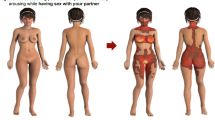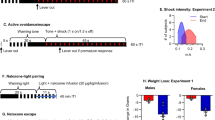Abstract
Fourteen rats were trained to discriminate the effects of γ-hydroxybutyrate (GHB) (sodium salt, 200 mg/kg) and saline in a two-lever choice task using a fixed ratio 10 schedule of water reinforcement. Intermediate responding, i.e., responding not fully appropriate for either training condition was observed in tests following morphine, lysergic acid diethylamide, chlordiazepoxide, and the presumed GABA-mimetics muscimol, γ-butyrolactone, baclofen, and 3-aminopropane sulfonic acid. Naloxone blocked the intermediate results following morphine, but had no effect on GHB-induced stimulus control. The GABA antagonist bicuculline partially blocked GHB, but pizotyline, phentolamine, and butaclamol were without effect. It is concluded that the compound stimulus produced by GHB is most closely associated with GABAergic systems, but that minor opiate and serotonergic components are present as well.
Similar content being viewed by others
References
Andén NE, Stock G (1973) Inhibitory effect of γ-hydroxybutyric acid and γ-aminobutyric acid on the dopamine cells in the substantia nigra. Naunyn Schmiedebergs Arch Pharmacol 279:89–92
Broughton R, Mamelak M (1979) The treatment of narcolepsy-cataplexy with nocturnal γ-hydroxybutyrate. J Can Sci Neurology 6:1–6
Doherty JD, Hattox SE, Snead OC, Roth RH (1978) Identification of endogenous γ-hydroxybutyrate in human and bovine brain. J Pharmacol Exp Ther 207:130–139
Goldstein A (1964) Biostatistics. MacMillan, New York London
Guidotti A, Ballotti PL (1970) Relationship between pharmacological effects and blood and brain levels of γ-butyrolactone and γ-hydroxybutyrate. Biochem Pharmacol 19:883–894
Hirschhorn ID, Winter JC (1971) Mescaline and lysergic acid diethylamide (LSD) as discriminative stimuli. Psychopharmacologia 22:64–71
Hirschhorn ID, Winter JC (1975) Differences in the stimulus properties of barbital and hallucinogens. Pharmacol Biochem Behav 3:343–347
Jouany JM, Gerard J, Broussolle B, Reynier M, Orsetti A, Vermuth C, Baron C (1960) Pharmacologie comparee des sels de l'acide butyrique et de l'acide 4-hydroxybutyrique. Agressologie 1:417–427
Laborit H, Jouany JM, Gerard J, Fabiani F (1960) Genéralités concernant l'étude experimentale de l'emploi clinique du γ-hydroxybutyrate de Na. Agressologie 1:397–406
Liljequist S, Engel J (1979) Attenuation of the γ-butyrolactone-induced increase in DOPA accumulation by chronic ethanol administration. J Neural Transm 46:195–204
Olpe HR, Koella WP (1979) Inhibition of nigral and neocortical cells by γ-hydroxybutyrate: A microiontophoretic investigation. Eur J Pharmacol 53:359–364
Osorio I, Davidoff RA (1979) Gamma-hydroxybutyric acid is not a GABA-mimetic agent in the spinal cord. Ann Neurol 6:111–116
Palumbo PA, Winter JC (1979) Discriminative stimulus properties of morphine, ketocyclazocine, and SKF 10047. Fed Proc 38:3297
Roth RH, Giarman NJ (1969) In vivo conversion of γ-aminobutyric acid to γ-hydroxybutyric acid in the rat. Biochem Pharmacol 18:247–250
Roth RH, Giarman JJ (1970) Natural occurrence of γ-hydroxybutyrate in mammalian brain. Biochem Pharmacol 19:1087–1093
Snead OC (1978) γ-Hydroxybutyrate in the monkey I. Electroencephalographic, behavioral, and pharmacokinetic studies. Neurology 28:636–648
Sytinsky IA, Soldatenkov AT, Lajtha A (1978) Neurochemical basis of the therapeutic effect of γ-aminobutyric acid and its derivatives. Prog Neurobiol 10:89–133
Tallman JF, Paul SM, Skolnick P, Gallagher DW (1980) Receptors for the age of anxiety: Pharmacology of the benzodiazepines. Science 207:274–281
Winter JC (1975) The stimulus properties of morphine and ethanol. Psychopharmacologia 44:209–214
Winter JC (1978) Drug-induced stimulus control. In: Blackman DE, Sanger DJ (eds) Contemporary research in behavioral pharmacology. Plenum, New York, p 209
Winters WD, Kott KS (1979) Continuum of sedation, activation, and hypnosis or hallucinosis: A comparison of low-dose effects of pentobarbital diazepam, of γ-hydroxybutyrate in the cat. Neuropharmacology 18:877–884
Winters WD, Wallach MB (1970) Drug-induced states of CNS excitation: A theory of hallucinosis. In: Efron DH (ed) Psychotomimetic drugs. Raven, New York, pp 193–214
Author information
Authors and Affiliations
Rights and permissions
About this article
Cite this article
Winter, J.C. The stimulus properties of γ-hydroxybutyrate. Psychopharmacology 73, 372–375 (1981). https://doi.org/10.1007/BF00426468
Received:
Accepted:
Issue Date:
DOI: https://doi.org/10.1007/BF00426468




